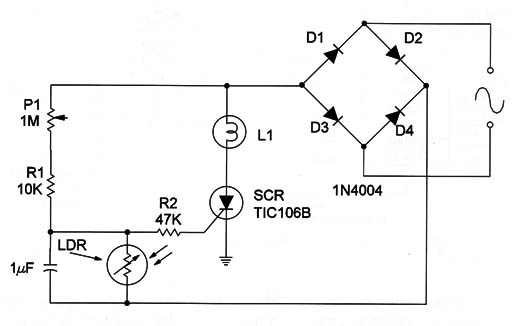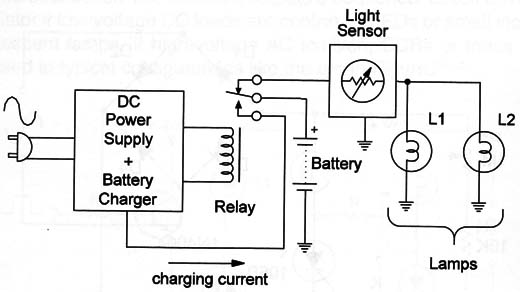An automatic light turns on a lamp at dusk and turns it off at dawn. This kind of control is found in many formats from Iamps plugged directly into the socket of a common incandescent Iamp (Figure 1) to more complex systems that can control aII the Iamps in a garden or on a street.

The sensor is an LDR or cadmium sulfide photocell that is mounted in such a way so that it receives onIy the ambient Iight and not the Iight from the Iamp it controls, thus avoiding feedback.
When the amount of Iight received by the sensor faIIs, the circuit triggers on a SCR or triac that turns on the Iamp.
As with any circuit using SCRs or triacs, this kind of control can generate some radio interference (refer to the section on SCRs, triacs, and EMI).
Depending on the application, the electrician must instaII filters in the AC power Iine into which the device is plugged. When working with these devices, it is important to be sure that the sensor onIy receives ambient Iight lf Iight from the Iamp is picked up by the sensor, a feedback process can make the circuit unstable.
Emergency Iights turn on one or more Iamps when the AC power fails. These Iights are required equipment in public places, such as restaurants, movie theaters, schools, and many others. The basic emergency Iighting circuit has an operation principle as shown in Figure 2.

A battery Charger is plugged into the AC power Iine, keeping a battery in a constant charging process. A relay or another switching circuit unplugs this bIock from the battery when the AC power fails and, at the same time, plugs the battery into the emergency lamps.
A photocell is placed between the blocks to give the circuit some “intelligence.” This block only turns on the lamps if the location is dark. It is not necessary to turn on the lamps during an emergency if the area is illuminated by natural light. In some systems there is an inverter between the battery and the lamps. This inverter is necessary to drive fluorescent lamps.
In this site the reader will find many practical circuits for automatic and emergency lighting. Advanced circuits can be created using microprocessors and other resources.



